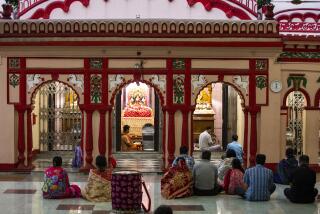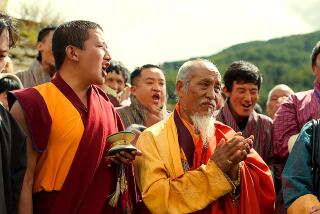Ethnic Discord : Clash of Cultures in Bhutan Spurs Emigration : Thousands of Nepalese residents have left, charging prejudice. But the government says many were living there illegally.
- Share via
DAGANA, Bhutan — Facing half a dozen men wearing their traditional swords of office, Budhi Man Mongar sweated slightly. Then he stepped forward in district court to make the biggest change of his life.
Carefully, the 43-year-old farmer affixed his fingerprint to thick documents permitting him to sell eight acres in the steep Himalayan foothills to the Bhutanese government. A few minutes later, under the glare of a videocam team’s lights, he pocketed his payment--the equivalent of nearly $10,000.
Mongar now was legally free to leave his lifelong home, and he, his wife and his five children were heading out shortly for southeastern Nepal to join relatives in Jhapa. But this was no ordinary family reunion: In Jhapa, they had heard, food and lodging are free--at a place that some see as a refugee camp and that others call a refuge for traitors.
“I’m going to take anything I can carry,” Mongar vowed as thick fog curled around the courthouse during a monsoon downpour. “Everyone else is taking all of their things too.”
Personal, not political, reasons prompted Budhi Man Mongar’s decision. But his departure--and that of tens of thousands of ethnic Nepalese like him--worries the government of Bhutan. Indeed, the tiny nation faces perhaps its gravest challenge ever: massive emigration from its southern crescent, the latest development in a political crisis that has brought assassination and deep suspicion to a formerly peaceable kingdom.
Some Nepalese contend that emigration represents a last-ditch move to maintain their cultural identity--although for many, it simply means keeping their families together. For the Bhutanese, however, it represents a significant threat to another kind of “family”--the one that King Jigme Singye Wangchuck has attempted to forge for all of his subjects through a common national identity transcending ethnic, cultural and religious differences.
“We are trying our level best to get them to stay,” explained Yeshey Dorji, the district administrator in isolated Dagana. “But they are trying their level best to get to their camps.”
More than 60,000 Nepalese now are living in camps near Jhapa--and with them they have brought charges of ingrained ethnic prejudice and forced eviction from Bhutan. Still, camp residents appear a confusing mix, with many reportedly coming from northeastern India or other parts of Nepal to take advantage of refugee aid. Despite the rumors that “everything is free,” independent observers label camp conditions abysmal.
For its part, the Bhutanese government is acutely aware that few monarchies survive in this era--much less are understood. And, seeking to protect its longstanding reputation for forward-looking policies, Bhutan does not want to be made into an international scapegoat.
At this point, little is known outside the eastern Himalayas about the undercurrent of ethnic tension here. What is clear, however, is that the strain has been growing for decades between Bhutanese, whose dominant Buddhist Drukpa culture is closely related to that of Tibet, and the largely Hindu Nepalese migrants who have spread across the region since the early part of this century.
“They want to take over,” one official lamented, referring to the idea that Nepalese should forge a common political entity. “They want Bhutan to be part of a Greater Nepal.”
Lured by fertile land and decreased population pressure, Nepalese trickled into Bhutan in the first half of this century and settled in five southern districts. After passage of the Nationality Act of 1958, which granted Bhutanese citizenship to Nepalese already in the country, tens of thousands of illegal migrants breached the border. Now they make up about one-third of the tiny country’s 600,000 population.
(Bhutan’s population previously had been reported as well over 1 million, but recently the official figures were revised sharply downward.)
Ethnic Bhutanese, mindful that Nepalese migrants already control neighboring Sikkim, fear their Drukpa culture could be swept away. And they are not alone in their concerns about the influx: In the last two years, India has “pushed back” 25,000 Nepalese who were illegally living in Assam and other northeastern states.
The flash point for the Bhutanese crisis came in 1988, when the government decided to adopt a firm immigration policy. Launching the nation’s first detailed census, it reclassified as illegal about 100,000 Nepalese who had arrived after 1958, many of whom had been falsely registered for years as “southern Bhutanese” citizens.
Nepalese alarm was deepened by the simultaneous renewal of emphasis on Bhutanese culture, including the teaching in all schools of Dzongkha, the national language, and the required wearing of distinctive Bhutanese dress by all ethnic groups.
As discontent grew, it led to formation of the opposition Bhutan People’s Party, an almost exclusively Nepalese group that characterizes itself as pro-democracy but that has been sharply condemned by the government. It is, charges Foreign Minister Dawa Tsering, “an out-and-out terrorist organization.”
The BPP, dismissing the existence of the National Assembly, in turn calls the current monarchy “feudal and reactionary” and instead demands a “real” constitutional monarchy. It also seeks amendments to the citizenship act, including an end to the 1958 cutoff; abolition of the traditional judicial system, and the right to preserve Nepalese culture, dress and language.
In September, 1990, the ideological differences climaxed with an organized uprising along the border by more than 15,000 “anti-nationals,” as the government calls its opponents. Officials and schoolchildren alike were stripped of their national dress, and government facilities were destroyed by the Nepalese.
The continuing turmoil deeply pains Wangchuck, who has pledged, “If I, as the king, cannot protect the sovereignty and integrity of our country and ensure a secure future for our people, then it will be my duty to accept full responsibility and abdicate.”
Although there have been no further mass demonstrations, the violence has continued, with reports of murder, burglary, beating and rape received virtually every week--mostly against Nepalese believed to be government loyalists. Even so, many Drukpas say they feel that all ethnic Nepalese, citizens or not, are suspect.
“Real Bhutanese are angered by (Nepalese) activities,” said one Dagana resident. “If you give them more, they demand more.”
In the most notorious recent incident, the victim was not Nepalese but a young Drukpa official. A group of gunmen last May assassinated Chimi Dorji, the deputy district administrator in Geylegphug, then fled across the border.
“The attack shocked everyone in the country,” said Yeshey Dorji, who is no relation to the slain man. “We never thought matters would come to this.”
Allegations that Nepalese have been forced out--particularly in the districts of Dagana and Chirang--began to surface last winter, prompting Wangchuck to issue an edict declaring it illegal for any citizen to be involuntarily removed.
“The charge of forcible eviction is not true,” Tsering, the foreign minister, said in an interview in the capital of Thimphu. The Nepalese “are making these allegations with impunity. They think a monarchy can only be an archaic police state.”
Those who want to legally leave Bhutan face a complex process that begins with an application to the village headman and ends with a brief court appearance. The procedure may take months, as officials delay in the hope that applicants will change their minds. Of those who have left, most are farmers, but more than 350 civil servants also have joined the exodus.
In recent weeks, the crisis took a particularly dramatic turn when 400 Nepalese families in Geylegphug claimed they were being forced out by the assassinated official’s successor. The king headed south.
“Short of literally going down on my knees with folded hands, I have tried everything possible to resolve the serious problem we have today in southern Bhutan,” Wangchuck was reported by the national newspaper, Kuensel, as telling the families. “I can now only hope and pray that you will stay back so that we can all live together like members of one household.”
His plea went unheeded, however--and the departing families allegedly looted or destroyed more than two dozen district facilities on their way out. Investigators found more than $80,000 in damages at schools, health units and other sites that had been stripped of equipment and declared baseless the charges that the assassinated man’s successor had pressured the Nepalese families to leave.
Meanwhile, Wangchuck struggles to keep the peace among his fractious subjects. Over strong objections of the National Assembly, he has granted amnesty to more than 1,500 people arrested in connection with anti-government activities and has exempted Nepalese from rural taxes this year. And in spite of further objections--likely to be renewed at this month’s National Assembly session--he resumed development activities in the south, which until the 1990 uprising garnered most of the large five-year budget allotments.
But the king’s efforts appeared not to matter to several farm families waiting recently for transportation to the border in Chirang’s tiny district capital, Damphu. Site of some of the most violent demonstrations in 1990, Chirang has been one of the hardest-hit districts for emigration. More than 6,000 out of its total population of 31,000 are already gone, while in Dagana, 5,000 out of 26,000 have left. Vast swaths of land lie uncultivated, lending a desolate air to the region.
District Administrator Sherab Dorji, named Chirang’s chief official last spring, said the number of cases has grown so large that they are clogging the bureaucracy. As in Dagana, each case is now videotaped so that there is evidence to refute any charges of forcible eviction.
Some clans, unlike the family of Budhi Man Mongar, are splitting up over the decision to move. Nandalal Kumai, a Dagana farmer who received nearly $35,000 for seven acres of prime land, said his older brother chose to stay back while Nandalal followed an uncle to Jhapa.
Kumai, 38, sounded more politically inclined than some emigrants. “When we (Nepalese) come back en masse,” he said, echoing a favorite BPP theme, “I’ll come back too.”
Budhi Man Mongar, meanwhile, doubted he would ever be back, although he wasn’t sure what he would do in Nepal.
“I haven’t thought about the future, but I’m not worried,” Mongar said as he turned to leave the Dagana court. Pausing, he added: “It’s not a question of whether this side is better or that side is better. My relatives are already there.”
A Tiny Kingdom Official name: Druk-Yul. Translates as “Land of the Thunder Dragon”
Head of state: King Jigme Singye Wangchuck
Population: 600,000
Life expectancy: males 48.1 years, females 46.8 years
Per-capita GNP: $400 (1991)
Religions: Tibetan Buddhist (state religion) 75%, Hindu 25%
Topography: High mountains in north, heavily forested hills and valleys in center and south; narrow plain along Indian border
History: Bhutan became unified in the 17th Century under Shabdrung Ngawang Namgyel, who founded separate spiritual and temporal hierarchies of government. This system lasted until the establishment of a monarchy in 1907.
Jigme Dorji Wangchuck, who reigned from 1952 to 1972, is considered the father of modern Bhutan. He launched a series of economic development plans and diplomatic initiatives linking his country to the rest of the world. Wangchuck’s son, the present monarch, has expanded upon these policies while emphasizing Bhutan’s traditions.
Sources: 1992 World Almanac, 1991 Information Please Almanac, Royal Government of Bhutan
More to Read
Sign up for Essential California
The most important California stories and recommendations in your inbox every morning.
You may occasionally receive promotional content from the Los Angeles Times.













